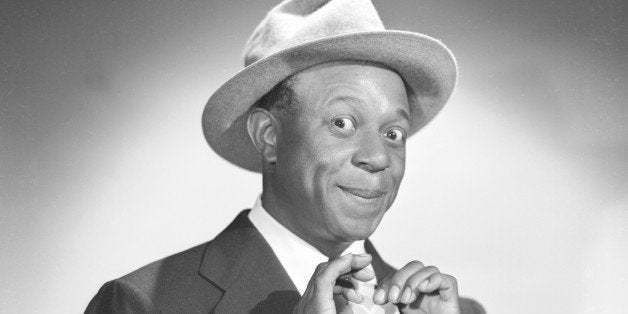
The year was 1937, and the first role offered Eddie Anderson on The Jack Benny Program on radio was that of a Pullman porter. It was to be a one-time part, but there was something about the gravely-voiced African-American actor that led the producers to use him again -- first as a waiter, and another time as a fellow who has an altercation with the star, Jack Benny.
Anderson's very identifiable, raspy voice, and his occasional return to the show, led audience members to write in requesting more of the actor.
With the audience interested in hearing more from Anderson, Jack and the producers invited him to come back for a regular part as Jack's valet. Lost to history is the story behind his character name, Rochester van Jones.
Pullman porter, waiter, valet -- these don't sound like breakthrough parts, but for an African-American actor who was accustomed to producers casting white men in the roles of black people (these were the days of Amos and Andy), these parts offered a major opportunity.
Eddie Anderson (1905-1977) became the first African American to have a regular role on a nationwide radio program, and of course, when Jack Benny moved to television, so did his valet, Rochester. Over time, Benny and Anderson became good friends and developed ways to make Anderson's role even better -- thereby giving African Americans a more important standing in American culture.
Who Was Eddie Anderson?
Eddie Anderson was born in Oakland, Calif., in 1905 to parents who had been performers. His father had been in minstrel shows, and his mother was a circus tightrope walker until an accident removed her from the business. According to Anderson, his forefathers had come from slavery and escaped the South via the Underground Railroad.
To help earn money for the family, young Eddie sold newspapers on the streets of San Francisco. The newsboys competed for sales by hailing customers as loudly as possible, and over time, Anderson permanently damaged his vocal cords.
Though he started in vaudeville at age 14 as part of a song-and-dance act, it was his distinctive voice that made him distinctly recognizable to listeners on radio.
In the late 1930s and '40s, Anderson and Benny appeared in films such as Man About Town (1939), Buck Benny Rides Again (1940) and Love Thy Neighbor (1940). Anderson also had parts in films that did not include Benny, ranging from Gone With the Wind (1939) to Stormy Weather (1943). Over his lifetime, Anderson appeared in some 60 films.
The Jack Benny Show
The humor and energy between Jack Benny and Eddie Anderson led to the development of a 20-year collaboration that delighted radio, television, and film audiences.
The men's relationship was solid on-air and off. Jack Benny refused to tolerate poor treatment of Anderson. In 1943 the company arrived in St. Joseph, Mo., where they planned to do one of their radio shows. Anderson and his wife were denied a hotel room, and only at Benny's urging did the hotel management find the Andersons a room.
Another time, in New York, a Southern couple complained about a black man staying in the hotel, so the manager approached Anderson suggesting that he find a room elsewhere. The show's producer got back to the manager and said that Anderson would leave the hotel the next day. The next morning all 44 members of the cast and crew checked out with Anderson and moved to another hotel.
During World War II, Benny often remarked on-air about African-American contributions to the war effort. In 1948, after the show reused a script from the early 1940s that contained issues that were racial stereotypes, Benny was displeased and ordered his writers to refrain from any sort of racial stereotype or slur. Rochester was to be considered an integral part of the show, and as his role evolved, it became typical for Rochester to cut through Benny's pomposity with comments like, "What's that, Boss?" African Americans warmed to the character and appreciated that Anderson had broken a barrier -- he was a black man playing the role of a black man, not a white man playing the role in blackface.
Anderson's Success
Anderson was well paid for his work; in 1942 he was earning $100,000 per year and was the highest-paid black actor in Hollywood at that time. He lived carefully, but he wanted a home built by African-American architect Paul Williams, so he commissioned that home on what is now Rochester Place in in the "Sugar Hill" section of Los Angeles (near Central Avenue and West Adams). The house still stands today.
Likely because they felt generally disenfranchised, the African Americans in the neighborhood held mock elections, and in 1940 Eddie Anderson ran for mayor of Central Avenue. Anderson was elected to this fabricated post, but he used the experience to speak out on real racial issues that were of concern to the community.
Anderson believed strongly that African Americans should be given the opportunity to fly for the military. He visited the Tuskegee Airfield and met with pilots there, and he owned a flight-related business, the Pacific Parachute Company, which made parachutes for the Army and Navy during World War II.
He also tried but failed to get funding from others to help him build a casino in Las Vegas that would welcome African Americans. However, when the Moulin Rouge Hotel opened in 1955 and promised to serve both blacks and whites, Anderson was a special guest at the opening.
He loved horse racing and began purchasing a few horses. The best-known horse he owned, Burnt Cork, ran in the 1943 Kentucky Derby, making Anderson the first African-American owner of a horse in the Kentucky Derby. He and his wife went to Louisville for the race, but because of segregation, they had to view the race from the home of Mae Street Kidd, an African-American Kentucky politician.
Eddie Anderson died on Feb. 28, 1977, in Los Angeles, Calif., leaving provisions for a foundation. His son, Eddie Jr., established a treatment center offering mental health and substance abuse services. That facility still operates today.
During the month of February, America Comes Alive will be sending out three profiles per week in honor of Black History Month. To receive these mailings, please write to me: kkelly@katekelly.com.
